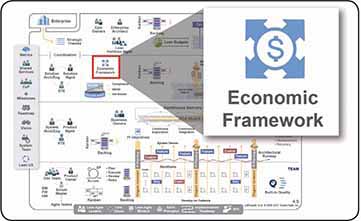

Take an economic view.
—SAFe Lean-Agile Principle #1
The Economic Framework is a set of decision rules that align everyone to the financial objectives of the Solution and guide the economic decision-making process. It contains four primary constructs: Lean Budgets, Epic funding and governance, decentralized decision-making, and job sequencing based on the Cost of Delay (CoD).
SAFe Lean-Agile Principle #1: Take an economic view highlights the key role of economics in successful solution development. This chapter describes the primary aspects of taking an economic view, delivering early and often, and understanding other economic trade-off restrictions. In addition, Principle #9: Decentralize decision-making is another cornerstone of SAFe.
These principles come together in this chapter, which describes the economic framework, a set of decision rules aligning everyone to the mission and its financial constraints. That includes budget considerations driven by the program portfolio, as well as trade-offs that affect a particular solution. In this context, portfolio fiduciaries can delegate decision-making authority to others, knowing that the resulting decisions will align with the agreed-to economic guidelines.
The primary purpose of the economic framework is to support effective, fast decision-making within the bounds of the larger economic picture. In turn, that requires three things:
An understanding of the rules for decision-making
The current local context
Relevant decision-making authority
To this end, many of the needed economic decision rules are embedded in various SAFe practices. Figure 1 summarizes where these rules and authorities occur. Each of these areas is described in the sections that follow.
The first decision is a big one, as the Lean-Agile enterprise moves from project-based, cost-center accounting to a more streamlined, leaner budget process, where the funding is allocated to long-lived Value Streams. Thereafter, the cost for each Program Increment (PI) is largely fixed, and the scope is varied as necessary. Each value stream budget can then be adjusted over time at PI boundaries, based on the relative value that each value stream provides to the portfolio. This process is described further in the Lean Budgets chapter.
Allocating funds to the value streams (and thereby to the Agile Release Trains [ARTs]) is all well and good. But what happens when there are substantial, crosscutting concerns, such as portfolio epics? Or significant local investment concerns, as represented by solution or program epics? Empowered funding requires the parallel responsibility to communicate the need for any unexpected investments—the primary purpose of the Portfolio Kanban System. Each epic requires a Lean business case and an explicit approval process (see the Epic chapter and the discussion of Lean portfolio governance in the Lean Portfolio Management chapter).
With these budget elements in place, the Enterprise then empowers people—particularly Product and Solution Management—with the relevant context, knowledge, and authority necessary to make content decisions at each level of the Framework. Of course, they don’t act alone, but rather collaborate with the larger stakeholder community to determine the best path. But in the end, the decision is theirs. That is their primary responsibility and authority.
Every significant program has a host of new backlog Features and Capabilities, just waiting to be implemented to increase the effectiveness of the solution. But SAFe is a flow-based system, whose economics are optimized by job-sequencing rather than theoretical job return on investment, or worse, first-come, first-served job selection. Picking the right next job is where the greatest economic benefit lies. This ability is enabled by the Program and Solution Kanban systems and the Program and Solution Backlog holding areas. Jobs are pulled into implementation based on the Weighted Shortest Job First (WSJF) model, using job size as the proxy for the job duration.
This chapter has described the constructs that provide a comprehensive foundation for effective decision-making based on the economics of the portfolio and value stream. SAFe also defines the roles and responsibilities of those who live in the decision-making chain. Of course, these decisions don’t make themselves. Lean-Agile Leaders continually apply these constructs and educate others in their use. This way, responsible decision-making happens throughout the development organization, bringing the full economic benefits of Lean-Agile development to the enterprise.
LEARN MORE
[1] Reinertsen, Donald G. The Principles of Product Development Flow: Second Generation Lean Product Development. Celeritas Publishing, 2009.